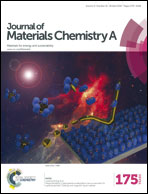Reversible anion intercalation in a layered aromatic amine: a high-voltage host structure for organic batteries†
Abstract
Cation insertion reactions in inorganic host frameworks are well-established phenomena. Over the last 40 years, a myriad of examples have been documented, which have given rise to key applications such as for electrochemical storage devices. By contrast, materials able to reversibly insert anions into their host lattice are rare, and consist essentially of graphite intercalation compounds (GICs), thus limiting their potential use. Organic materials, conversely, if properly designed, could pave the way for future developments in anionic insertion electrochemistry, by virtue of the rational incorporation of p-type redox-active organic moieties. Here, we report the discovery of a p-type organic host lattice based on a simple crystallized aromatic diamine. The reversible anion insertion process relies on the electrochemical activity of neutral secondary amino groups incorporated into a robust terephthalate backbone. XRD, TEM and EELS studies reveal the attainment of a unique lamellar structure conducive to the oxidative insertion of anions (including the bulky TFSI−). In a dual-ion cell configuration using lithium as the negative electrode, this organic structure can react reversibly at high operating potential (〈E〉 ≈ 3.22 V vs. Li+/Li) with good cycling performance even without carbon addition, hence generating further avenues for the development of organic batteries and more generally, the field of intercalation chemistry.


 Please wait while we load your content...
Please wait while we load your content...